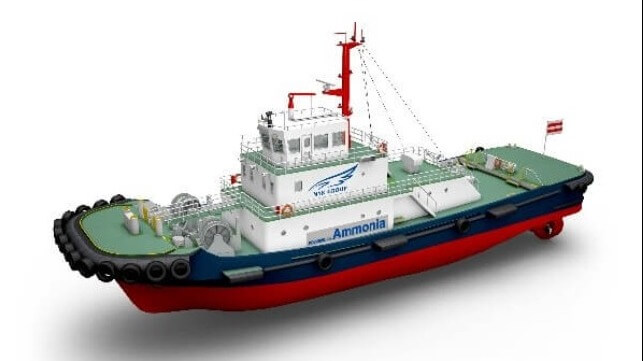Design Approval Overcomes Challenges for First Ammonia-Fueled Tug

Designs for what could become the world’s first ammonia-fueled tugboat received class approval overcoming the unique challenges that are associated with the cruise of ammonia. The vessel is being designed as part of a broad Japanese collation focusing on green technologies and they report that their goal is to demonstrate the tug at the port of Yokohama in 2024.
The Approval in Principle (AiP) was awarded by the Japanese classification society Nippon Kaiji Kyokai (ClassNK) to NYK Line and IHI Power Systems Co. NYK is responsible for the hull design and overseeing the construction and certification of the vessel in the project. IHI developed the design for a 4-stroke engine and will build the engine for the tugboat.
“By using ammonia as a fuel for ships, it will be possible to significantly reduce greenhouse gas (GHG) emissions during voyages,” points out NYK while also highlighting design challenges for using ammonia as the vessel’s fuel. “For this AiP, NYK Line and IPS attempted a design to safely and practically install ammonia fuel-related equipment in a limited space on board by developing an ammonia fuel engine, selecting equipment, and devising the equipment layout in the design.”
The companies reported that they were able to overcome unique challenges to achieve the design for A-Tug, without changing the size of a conventional tugboat. The main design issues identified by the project when using ammonia as a fuel included the necessity to combust ammonia stably and operate the engine while increasing the usage ratio of ammonia, which is flame-retardant and has low energy density.
In addition, since the combustion of ammonia generates high levels of nitrous oxide (N2O) instead of CO2, it is necessary to control the combustion to prevent the generation of nitrous oxide. In addition, capture systems are required not to discharge N20 overboard.
Finally, the vessel also needs to have a design to prevent potential leaks of ammonia which is toxic when released in large quantities into the environment. Adequate safety measures are required in the event of a leak. Safety measures based on risk assessment are necessary to ensure the same level of safety as conventional vessels.
The project to develop the designs for A-Tug began in 2020 as part of the Green Innovation Fund project with Japan’s New Energy and Industrial Technology Development Organization (NEDO). This R&D is for the development of vessels equipped with a domestically produced ammonia-fueled engine. The engine designs were adopted in October 2021 and recently the partners reached an agreement with Yokohama as the location for the first demonstration of the tug.
The Japanese government is funding broad research into ammonia-fueled vessels and the development of the necessary systems in support of the shipping and shipbuilding industries. In addition to projects focusing on domestically-developed engines, Mitsui O.S.K. Lines and Mitsubishi are involved in a project to design ammonia-fueled gas carriers which they hope to launch by 2026. Efforts are also focusing on ammonia-fueled bunker vessels while Sumitomo and Oshima Shipbuilding are working on ammonia-fueled bulkers.
